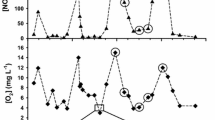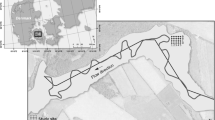Abstract
Redox potentials (Eh) were monitored bimonthly and porewater chemistry was analyzed seasonally at three slightly-acidic, high-elevation Kentucky wetlands that differed in hydrology, parent materials, and vegetation. At all sites, Eh values were below 300 mV, which indicated that reducing conditions persisted within the upper 90 cm and fluctuated mainly within the range of iron and sulfate reduction. Significant relationships of Eh values with depth were observed only at the Martins Fork wetland, where precipitation was the primary water source. The strongest and most stable reducing conditions, observed at the Kentenia site, reflected consistently high water levels, which were sustained by ground water. The third wetland (Four Level) was distinguished by irregular Eh fluctuations coinciding with strong seasonal ground-water upwelling. Although Fe3+ and SO4 2− were the primary terminal electron acceptors in all wetlands, porewater chemistry also varied significantly by season and soil depth in response to piezometric water level fluctuations. Additional factors that influenced porewater chemistry included: (1) the presence of limestone parent materials that affected porewater pH, Ca2+, and Mg2+; and (2) the prevalence of sphagnum moss or graminoid species that influenced dissolved organic carbon, CO2, and CH4. Results from this study indicated the diverse range and importance of multiple factors in controlling biogeochemical processes and properties in small, high-elevation Appalachian wetlands.









Similar content being viewed by others

References
Aerts R, Verhoeven JTA, Whigham DF (1999) Plant-mediated controls on nutrient cycling in temperate fens and bogs. Ecology 80:2170–2181
Amon JP, Thompson CA, Carpenter QJ, Miner J (2002) Temperate zone fens of the glaciated midwestern USA. Wetlands 22:301–317
Bennett PC, Siegel DI, Hill BM, Glaser PH (1991) Fate of silicate minerals in a peat bog. Geology 19:328–331
Butler JN (1982) Carbon dioxide equilibria and their applications. Addison-Wesley, Reading
Childress JD (1992) Soil survey of Bell and Harlan counties, Kentucky. Soil Conservation Service, U.S. Department of Agriculture
Clesceri LS, Greenberg AE, Eaton AD (eds) (1998) Standard methods for the examination of water and wastewater, 20th edn. APHA–AWWA–WEF, Washington, DC
Csejtey B Jr (1971) Geologic map of the Bledsoe Quadrangle, southeastern Kentucky. U.S. Geologic Survey, Washington, DC, USA. Quadrangle Map GQ-889
Dalva M, Moore TR (1991) Sources and sinks of dissolved organic carbon in a forested swamp catchment. Biogeochemistry 15:1–19
D’Angelo EM, Reddy KR (1994) Diagenesis of organic matter in a wetland receiving hypereutrophic lake water: I. Distribution of dissolved nutrients in the soil and water column. J Environ Qual 23:928–936
D’Angelo EM, Reddy KR (2003) Effect of aerobic and anaerobic conditions on chlorophenol sorption in wetland soils. Soil Sci Soc Am J 67:787–794
D’Angelo EM, Crutchfield J, Vandiviere M (2001) Rapid, sensitive, microscale determination of phosphate in water and soil. J Environ Qual 30:2206–2209
de Mars H, Wassen MJ (1999) Redox potentials in relation to water levels in different mire types in the Netherlands and Poland. Plant Ecol 140:41–51
Devito KJ, Hill AR (1999) Sulphate mobilization and pore water chemistry in relation to groundwater hydrology and summer drought in two conifer swamps on the Canadian Shield. Water Air Soil Pollut 113:97–114
Donahoe RJ, Liu C (1998) Pore water geochemistry near the sediment-water interface of a zoned, freshwater wetland in the southeastern United States. Environ Geol 33:143–153
Englund KL, Smith HL, Harris LD, Stephens JG (1961) Geology of the Ewing Quadrangle, Kentucky and Virginia. U.S. Geologic Survey, Washington, DC, USA. Quadrangle Map GQ-172
Faulkner SP, Patrick WH Jr, Gambrell RP (1989) Field techniques for measuring wetland soil parameters. Soil Sci Soc Am J 53:883–890
Gale PM, Reddy KR, Graetz DA (1992) Mineralization of sediment organic matter under anoxic conditions. J Environ Qual 21:394–400
Hesslein RG (1976) An in situ sampler for close interval pore water studies. Limnol Oceanogr 21:912–914
Ma S, Luther GW III, Keller J, Madison AS, Metztger E, Megonigal JP, Emerson D (2008) Solid-state Au/Hg microelectrode for the investigation of Fe and Mn cycling in a freshwater wetland: implications for methane production. Electroanalysis 20:233–239
Marin LE, Kratz TK, Bowser CJ (1990) Spatial and temporal patterns in the hydrogeochemistry of a poor fen in northern Wisconsin. Biogeochemistry 11:63–76
Reddy KR, D’Angelo EM, Harris WG (2000) Biogeochemistry of wetlands. In: Sumner ME (ed) Handbook of soil science. CRC Press, Boca Raton, pp G89–G119
Reeve AS, Siegel DI, Glaser PH (1996) Geochemical controls on peatland pore water from the Hudson Bay Lowland: a multivariate statistical approach. J Hydrol 181:285–304
Schwintzer CR, Tomberlin TJ (1982) Chemical and physical characteristics of shallow ground waters in northern Michigan bogs, swamps, and fens. Am J Bot 69:1231–1239
Seybold CA, Mersie W, Huang J, McNamee C (2002) Soil redox, pH, temperature, and water-table patterns of a freshwater tidal wetland. Wetlands 22:149–158
Shannon RD, White JR (1996) The effects of spatial and temporal variations in acetate and sulfate on methane cycling in two Michigan peatlands. Limnol Oceanogr 41:435–443
Thibodeaux LJ (1979) Chemodynamics. Wiley-Interscience, New York
Thompson Y, Sandefur BC, Miller JO, Karathanasis AD (2007) Hydrologic and edaphic characteristics of three mountain wetlands in southeastern Kentucky, USA. Wetlands 27:174–188
Vepraskas MJ, Faulkner SP (2001) Redox chemistry of hydric soils. In: Richardson JL, Vepraskas MJ (eds) Wetland soils: genesis, hydrology, landscapes, and classification. CRC Press, Boca Raton, pp 85–105
Verhoeven JTA, Toth E (1995) Decomposition of Carex and Sphagnum litter in fens: effect of litter quality and inhibition by living tissue homogenates. Soil Biol Biochem 27:271–275
Verhoeven JTA, Keuter A, Van Logtestijn R, Van Kerkhoven MB, Wassen M (1996) Control of local nutrient dynamics in mires by regional and climatic factors: a comparison of Dutch and Polish sites. J Ecol 84:647–656
Villar C, de Cabo L, Vaithiyanathan P, Bonetto C (1999) Porewater N and P concentration in a floodplain marsh of the lower Paraná River. Hydrobiologia 392:65–71
Vitt DH, Chee WL (1990) The relationships of vegetation to surface water chemistry and peat chemistry in fens of Alberta, Canada. Vegetatio 89:87–106
Wheeler BD, Shaw SC (1995) A focus on fens—controls on the composition of fen vegetation in relation to restoration. In: Wheeler BD, Shaw SC, Fojt WJ, Robertson RA (eds) Restoration of temperate wetlands. Wiley, New York, pp 49–72
Wieder RK (1985) Peat and water chemistry at Big Run Bog, a peatland in the Appalachian Mountains of West Virginia, USA. Biogeochemistry 1:277–302
Wieder RK, Lang GE (1988) Cycling of inorganic and organic sulfur in peat from Big Run Bog, West Virginia. Biogeochemistry 5:221–242
Wieder RK, Yavitt JB, Lang GE (1990) Methane production and sulfate reduction in two Appalachian peatlands. Biogeochemistry 10:81–104
Wilcox DA, Shedlock RJ, Hendrickson WH (1986) Hydrology, water chemistry, and ecological relations in the raised mound of Cowles Bog. J Ecol 74:1103–1117
Yavitt JB (1994) Carbon dynamics in Appalachian peatlands of West Virginia and western Maryland. Water Air Soil Pollut 77:271–290
Acknowledgments
Cumberland Gap National Historic Park and Kentucky State Nature Preserves Commission provided access to the study sites.
Author information
Authors and Affiliations
Corresponding author
Rights and permissions
About this article
Cite this article
Thompson, Y., Sandefur, B.C., Karathanasis, A.D. et al. Redox Potential and Seasonal Porewater Biogeochemistry of Three Mountain Wetlands in Southeastern Kentucky, USA. Aquat Geochem 15, 349–370 (2009). https://doi.org/10.1007/s10498-008-9042-3
Received:
Accepted:
Published:
Issue Date:
DOI: https://doi.org/10.1007/s10498-008-9042-3



